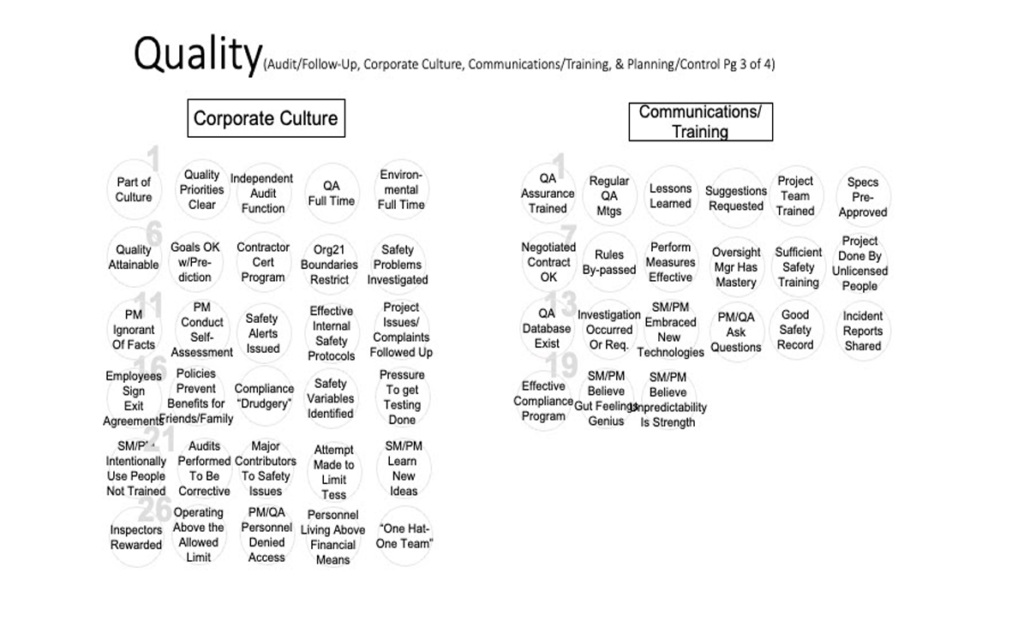
CORPORATE CULTURE:
1 – Is quality assurance/ control a part of the organization’s corporate culture?
2 – Are quality priorities clearly stated?
3 – Is there an independent audit function?
4 – Are quality assurance people assigned to the organization full time?
5 – Are environmental specialists assigned to the organization full time?
6 – Are the desired quality levels attainable?
7 – Are the quality goals in line with the organization’s prediction?
8 – Is there a contractor certification program?
9 – Are organizational boundaries restrictive? Are boundaries disregarded?
10 – Potential safety problems are timely, fully and impartially investigated?
11 – Is project manager/ senior management indifferent, ignorant of or confused about facts submitted by quality assurance personnel
12 – Does/ did PM conduct a self-assessment of this project?
13- Are safety alerts issued to the project team, PM, senior management, customers and appropriate regulatory agencies?
14 – Does project have effective internal safety protocols? (No = red)
15 – Are project issues/ complaints followed up? (No = red)
16 – Must employees sign exit agreements preventing them from benefitting from whistleblowing?
17 – Do policies exist to prevent executives/officials/ employees/ contractors from using their position to obtain benefits for themselves, relatives, household members, friends, clients? (No = bad)
18 – Do leadership/ project professionals openly demean compliance as “drudgery”? (Yes = bad)
19 – Are safety/ cyber stand downs ordered by leadership after mishaps to determine causes, review basics and reiterate preventive/ corrective actions? Have all possible relevant safety variables been identified (Yes = good)
20 – Is extreme pressure exerted to get testing done/ avoid/ falsify/ under-report/ ignore testing/ science? (Yes = blue)
21 – Does SM/PM intentionally use people who are not fully trained/ certified to perform work requiring certification? (Yes = bad)
22 – Are audits performed to be nurturing and corrective? (No = bad)
23 – Can PM identify the major contributors to safety issues? (No = bad)
24 – Is any attempt being made to limit the number (e.g. cherry picking) of tests in order to improve possible performance ratings? (Yes = bad)
25 – Is the SM/ PM and team willing to learn new ideas/ technologies from the ‘outside’ and bring that learning to the project? (Yes = green)
26 – Are inspectors being rewarded for passing equipment that has failed testing? (Yes = bad)
27 – Are any activities happening/ operating above the allowed limit? (Yes = blue)
28 – Are PM/ QA personnel denied access to review operations/ team/ contractor spaces where work is being performed? (Yes = blue)
29 – Are any project personnel living inexplicably above their financial means (if yes, possible fraud situation)?
30 – Does SM/ PM emphasize a ‘one hat – one team’ approach to enable effective teamwork?
—————————-
COMMUNICATIONS/TRAINING:
1 – Have the quality assurance people been formally trained?
2 – Are regular quality assurance meetings held to review findings?
3 – Are “lessons learned” documents prepared for this project?
4 – Are quality assurance suggestions requested?
5 – Has the project team been trained/ oriented in quality assurance?
6 – Are/ were specifications pre-approved (agreed to in advance)?
7 – Was the negotiated contract ok?
8 – Were established rules or procedures by-passed?
9 – Were/ are performance measures effective?
10 – Contractor Oversight System manager has a mastery of the system’s nuts and bolts?
11 – Have project personnel received sufficient safety training for the jobs they are doing? (No = bad)
12 – Are parts of the project done, awaiting approval, done by unlicensed people?
13 – Does a quality assurance database exist to track items requiring follow-up and reporting out? (Yes = good)
14 – Is there any evidence that SM/ PM can produce that an investigation (of any kind) or investigation has ever occurred or been requested? (No = blue)
15 – Has SM/ PM embraced new technologies without proper/ adequate testing (belief without evidence) or input from affected stakeholders? (Yes = bad)
16 – Does the PM/ QA management exhibit a questioning attitude and ask questions about issues they are uncomfortable with? (Yes = good). Chooses to bury their heads in the sand? (Yes = bad)
17 – Does the manufacturer/ vendor/ contractor have a good safety record? (Yes = good)
18 – Do manufacturers/ vendors/ contractors share incident reports from customers/ users with the PM/QA department? (Yes = good)
19 – Does PM/QA have an effective compliance program that includes internal controls and procedures that can be used to communicate with senior management and regulators? (Yes = good)
20 – Does SM/ PM believe that her/ his gut feeling are genius – regardless of reality? (Yes = bad)
21 – Does SM/ PM believe their unpredictability is a personal strength? (Yes = bad)
